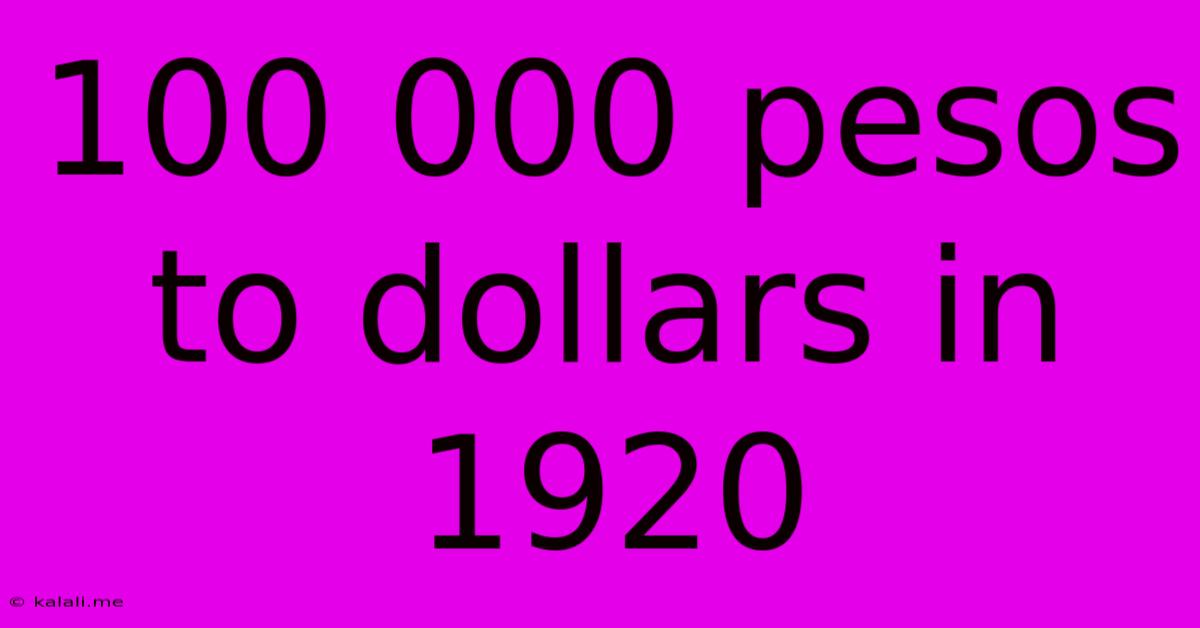100 000 Pesos To Dollars In 1920
Kalali
May 25, 2025 · 3 min read

Table of Contents
100,000 Pesos to Dollars in 1920: Uncovering the Purchasing Power of a Fortune
The year is 1920. Flappers dance the Charleston, the roaring twenties are just beginning, and 100,000 pesos represents a significant sum. But how much is that in today's dollars? Converting historical currency requires more than a simple exchange rate; it necessitates understanding the purchasing power of money across time. This article delves into the complexities of converting 100,000 pesos to US dollars in 1920, considering the fluctuations in exchange rates and the crucial concept of inflation.
Understanding the Challenges of Historical Currency Conversion
Directly converting 100,000 pesos to US dollars using a 1920 exchange rate provides only a nominal value. The true worth, however, depends heavily on the purchasing power parity (PPP) – what goods and services that amount could buy then, compared to what that same amount can buy today. Inflation significantly erodes the value of money over time. A simple exchange rate conversion ignores this crucial factor.
Several factors complicate the process:
- Fluctuating Exchange Rates: The peso-dollar exchange rate in 1920 wasn't fixed. It varied based on economic conditions and international trade. Finding a precise average rate for the entire year requires research into historical financial records.
- Different Types of Pesos: The term "pesos" in 1920 could refer to various currencies from different countries. Knowing the specific country of origin of the pesos is vital for accurate conversion. For example, Mexican pesos, Philippine pesos, and Argentinian pesos all existed.
- Inflationary Pressures: The inflation rates of both the peso and the dollar differed significantly between 1920 and the present day. Accounting for this differential is crucial for understanding the true purchasing power.
Methods for Estimating the 1920 Value
Several approaches can help us estimate the value of 100,000 pesos in 1920 in today's dollars:
- Using Historical Exchange Rates: Research historical financial data to find the average peso-dollar exchange rate for 1920. This gives a nominal conversion. However, remember this ignores inflation.
- Applying Inflation Calculators: Several online inflation calculators can adjust for inflation. You'll need to input the nominal value obtained from the exchange rate and the start and end years. These calculators typically use indices like the Consumer Price Index (CPI) to estimate the change in purchasing power.
- Considering Relative Prices: Researching the prices of common goods in 1920 (e.g., bread, housing, transportation) and comparing them to today's prices offers another perspective. This method provides a more qualitative understanding of the purchasing power.
Conclusion: A Complex Calculation with No Single Answer
Precisely converting 100,000 pesos to dollars in 1920 requires extensive historical research and careful consideration of various economic factors. There's no single definitive answer. While an approximate nominal conversion using a historical exchange rate can be obtained, understanding its true purchasing power requires adjusting for inflation using relevant indices or by comparing the cost of goods and services. The result will be a far larger figure in today’s dollars than a simple exchange rate calculation would suggest, highlighting the dramatic impact of inflation over the past century. Further research into specific historical records would yield a more precise, albeit still an estimate, of the real value of this considerable sum in 1920.
Latest Posts
Latest Posts
-
How To Get A Screw Unstuck
May 26, 2025
-
Simplify Your Answer As Much As Possible
May 26, 2025
-
Can You Substitute Butter With Vegetable Oil
May 26, 2025
-
Do You Capitalize With In A Title
May 26, 2025
-
Cosine Of A Normal Random Variable
May 26, 2025
Related Post
Thank you for visiting our website which covers about 100 000 Pesos To Dollars In 1920 . We hope the information provided has been useful to you. Feel free to contact us if you have any questions or need further assistance. See you next time and don't miss to bookmark.